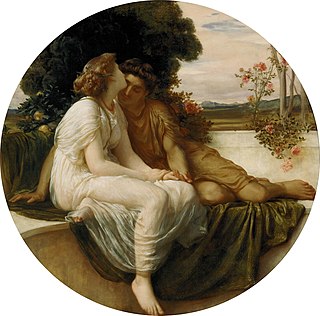Related Research Articles

Gaius Valerius Catullus, called Catullus, was a Latin neoteric poet of the late Roman Republic. His surviving works remain widely read due to their popularity as teaching tools and more personal or sexually explicit themes.
Marcus Caelius Rufus was an orator and politician in the late Roman Republic. He was born into a wealthy equestrian family from Interamnia Praetuttiorum, on the central east coast of Italy. He is best known for his prosecution of Gaius Antonius Hybrida in 59 BC. He was also known for his trial for public violence in March 56 BC, when Cicero defended him in the extant speech Pro Caelio, and as both recipient and author of some of the best-written letters in the ad Familiares corpus of Cicero's extant correspondence. He may be the Rufus named in the poems of Catullus.

Lesbia was the literary pseudonym used by the Roman poet Gaius Valerius Catullus to refer to his lover. Lesbia is traditionally identified with Clodia, the wife of Quintus Caecilius Metellus Celer and sister of Publius Clodius Pulcher; her conduct and motives are maligned in Cicero's extant speech Pro Caelio, delivered in 56 BC.

Catullus 64 is an epyllion or "little epic" poem written by Latin poet Catullus. Catullus' longest poem, it retains his famed linguistic witticisms while employing an appropriately epic tone.

Catullus 3 is a poem by Roman poet Gaius Valerius Catullus that laments the death of a pet sparrow (passer) for which an unnamed girl (puella), possibly Catullus' lover Lesbia, had an affection. Written in hendecasyllabic meter, it is considered to be one of the most famous of Latin poems.

Catullus 2 is a poem by Roman poet Gaius Valerius Catullus (c. 84 – c. 54 BCE) that describes the affectionate relationship between an unnamed puella ('girl', possibly Catullus' lover, Lesbia), and her pet sparrow. As scholar and poet John Swinnerton Phillimore has noted, "The charm of this poem, blurred as it is by a corrupt manuscript tradition, has made it one of the most famous in Catullus' book." The meter of this poem is hendecasyllabic, a common form in Catullus' poetry.
Catullus 101 is an elegiac poem written by the Roman poet Gaius Valerius Catullus. It is addressed to Catullus' dead brother or, strictly speaking, to the "mute ashes" which are the only remaining evidence of his brother's body.

Catullus 7 is a poem by Catullus addressed to his mistress Lesbia. Similar to Catullus 5, this poem revels in counting kisses, with a touch of stellar voyeurism.

Catullus 6 is a Latin poem of seventeen lines in Phalaecean hendecasyllabic metre by the Roman poet Catullus.

Catullus 8 is a Latin poem of nineteen lines in choliambic metre by the Roman poet Catullus, known by its incipit, Miser Catulle.
Catullus 9 is a Latin poem of eleven lines in Phalaecean metre by the Roman poet Catullus.

Catullus 10 is a Latin poem of thirty-four lines in Phalaecean metre by the Roman poet Catullus.
Elmer Truesdell Merrill was an American Latin scholar, born at Millville, Massachusetts. Merrill graduated from Wesleyan University in 1881. He is primarily remembered for his student edition of the Roman poet Catullus and for his studies on the text and tradition of the Letters of Pliny the Younger, culminating in his 1914 Teubner edition, which constituted an important basis for the works of later scholars.

Catullus 5 is a passionate ode to Lesbia and one of the most famous poems by Catullus. The poem encourages lovers to scorn the snide comments of others, and to live only for each other, since life is brief and death brings a night of perpetual sleep. This poem has been translated and imitated many times.

The poetry of Gaius Valerius Catullus was written towards the end of the Roman Republic. It describes the lifestyle of the poet and his friends, as well as, most famously, his love for the woman he calls Lesbia.
Catullus 16 or Carmen 16 is a poem by Gaius Valerius Catullus. The poem, written in a hendecasyllabic (11-syllable) meter, was considered to be so sexually explicit following its rediscovery in the following centuries that a full English translation was not published until the 20th century. The first line, Pēdīcābo ego vōs et irrumābō, sometimes used as a title, has been called "one of the filthiest expressions ever written in Latin—or in any other language".

Catullus 36 is a Latin poem of twenty lines in Phalaecean metre by the Roman poet Catullus.
Catullus 63 is a Latin poem of 93 lines in galliambic metre by the Roman poet Catullus.

Catullus 42 is a Latin poem of twenty-four lines in Phalaecean metre by the Roman poet Catullus.